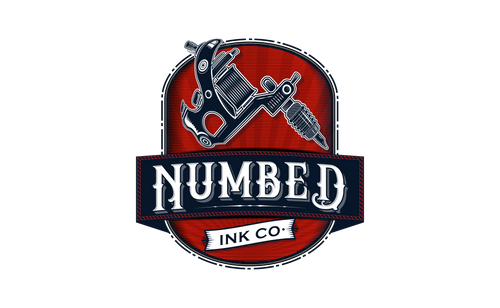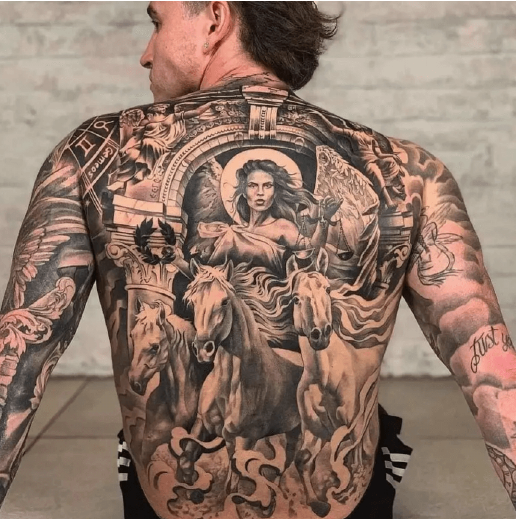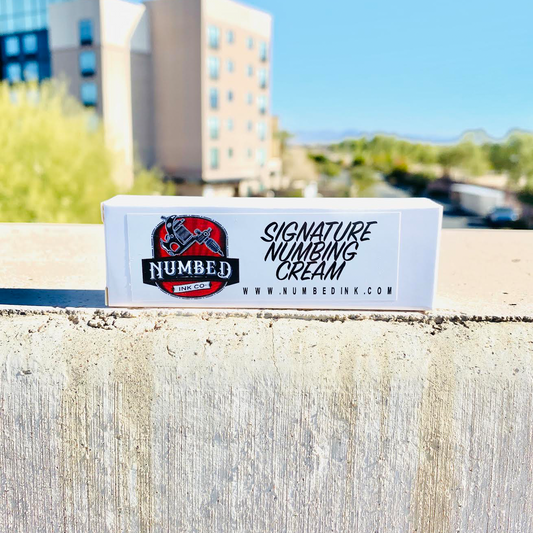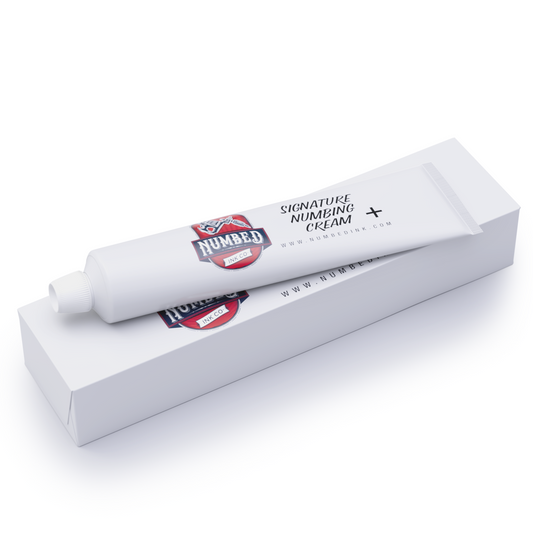Depending on size, location, and skin type, aftercare for your back tattoo might look a bit different than someone else’s.
Larger tattoos that take several sessions to complete will likely hurt more and take longer to heal than a smaller one. Similarly, fresh ink on your love handles or upper back or lower neck will probably hurt more than a piece on your shoulder blades.
But no matter how big it is, where it is, or your skin type, we have you covered with everything you need to know about back tattoo aftercare.
How do you take care of a tattoo on your back?
The essentials
As with any tattoo, there are a few things that you must do to properly care for it. Despite your beautiful new ink, your tattoo is a fresh wound and must be treated with care.
To protect your tattoo, be sure to care for the wound, avoid common sources of bacteria (swimming, sunlight, dirty clothes, etc.), and monitor for any signs of an infection.
How to clean a back tattoo
To properly clean your new back tattoo, choose an antibacterial, fragrance-free liquid or bar soap. We recommend using fragrance-free soaps as most soaps contain chemicals that irritate and damage the skin.
Avoid using any moisturizing soaps or soap scrubs as they can also cause irritation and scratch the healing skin.
Do not use a washcloth, loofah, or brush to clean the area. Though these may allow you to reach the area, they harbor bacteria and will scratch the skin, leading to infections and damaged ink.
Depending on the location on your back, it might be very difficult to clean the area yourself. If you’re fortunate enough to have a partner help clean your tattoo, make sure they wash their hands before cleaning the area.
If you are by yourself, you may have to get a bit creative. To avoid too much bending & contortion, which can cause scabs to break early, try this solution.
Tape a piece of plastic wrap to your shower door/wall, cover it with soap, and use your own body weight to gently clean the area. Once you’re done, repeat the same process with a damp, disposable paper towel to remove the excess soap.
When to clean it?
You should clean the tattoo at least twice per day. To make it easy, clean it right when you wake up and right before you go to bed.
We’ll get to sleeping with a back tattoo in a bit.
How to moisturize a back tattoo
What to apply
Similar to the soap, you should use a scent-free or fragrance-free white cream lotion or moisturizer.
And if you’re looking for an all-in-one solution for your back tattoo, check out our Ink Balm. It’s the best aftercare for your new ink, protecting your art and your skin from the start.
Use 1-2x daily instead of lotion to relieve pain & itchiness and prevent infections, all while properly moisturizing and maintaining your tattoo’s vibrance.
Why moisturizing is important
Moisturizing is an important part of the tattoo healing process. It helps your skin regenerate more quickly, reduce irritation, and create the overall best environment for your skin cells to heal the damaged skin.
Though you may have heard that it’s best to let wounds “dry out,” that could not be more wrong when it comes to tattoos.
Dry skin reduces cellular activity and delays the healing process. And, dry skin is more susceptible to bacterial infections, which will ruin your tattoo.
When to moisturize
Apply lotion or Ink Balm as soon as the area begins to dry out, which usually occurs in the first 1 to 3 days after your session.
Apply 3-5 times per day for at least the first two weeks and be sure not to over-moisturize. Yes, it’s possible, and it can lead to clogged pores and acne around the ink.
How to sleep with a back tattoo
The most obvious question is “can you sleep on your back after a back tattoo?” The short answer is no, sleeping directly on the area will damage the ink and potentially cause infections.
For at least the first couple weeks, sleep on your chest or side. If you typically sleep on your back, here are a few tips to sleep comfortably without damaging your tattoo.
Sleep on your chest by placing a flat pillow underneath your lower stomach/pelvis to support your lower back. If you want to try sleeping on your side, hug a large body pillow or place a smaller pillow between your legs to prevent you from rolling onto your back.
These aren’t perfect solutions. So if you do manage to twist and turn all night and the sheets become stuck to your skin, don’t try to tear them away from your skin.
Instead, make your way over to the bathroom and run some warm water on the area to separate the two without damaging your skin. Then, you'll have to clean your sheets.
Your position is only part of the process. Here are some more tips to help you sleep while your back piece heals:
- Clean your sheets before sleeping. Unwashed sheets have the potential to cause infections.
- Your skin needs to remain at a comfortable temperature, so don’t sleep underneath a bunch of heavy blankets and sheets.
- Wear loose fitting clothing to let your skin breathe. Some blood or ink may stain your shirt, so be sure to wear an old shirt that you aren’t worried about damaging.
- For the first few nights, cover the area with plastic wrap to seal it off from bacteria and prevent any scabs from being ripped off.
- We know you love your pet, but pets are a breeding ground for bacteria. If they normally sleep on the bed, leave them off the bed for the first few nights while your ink heals.
What to wear while a back tattoo is healing
As with sleeping, the best thing to wear while your back tattoo is healing is loose fitting clothing that allows your skin to breathe.
For women, avoid wearing a bra for the first few days after your session to avoid any scratching or infections, especially if the bra straps are likely to rub against the healing area.
If you must wear a bra, make sure to clean both the bra and your tattoo to avoid any infections. If possible, wear a loose fitting sports bra or one with a low back strap. And as with your clothes, it’s important to note that fresh ink and/or blood may stain your bra.
Don’t go swimming
Pools, lakes, and oceans are a must-avoid for the first few weeks after your back tattoo. These bodies of water are not sterile and will almost certainly damage your ink.
First and foremost, your healing skin will be exposed to millions of microbes, likely leading to a serious bacterial infection.
Second – chlorine and other pool chemicals can negatively affect the color, vibrance, and overall cosmetic appearance of the masterpiece that you just added to your skin.
Depending on the size & location of your tattoo, you might have to stay out of the water anywhere from two short weeks to three months. If you absolutely have to get wet, cover the entire tattoo area with a waterproof bandage.
For larger pieces, it’s recommended to fully avoid water as it’s nearly impossible to cover the entire area.
And if you are exposed to potentially-contaminated water, clean the area immediately afterwards.
Avoid the sun
Your tattoo is finally done and now you want to show it off. Well, you’re going to have to wait a little bit longer.
Though you might be looking to add a tan to complete your new look, you should avoid the sun for at least the first 3-4 weeks after your session to avoid damaging the ink and your healing skin.
Because tattoos are open wounds and more exposed to external elements, even a few minutes of sun exposure can fade, crack, and/or blister your tattoo.
To protect your skin from the sun, wear loose fitting clothes and sunscreen for extra protection. For the best protection, use a broad-spectrum, fragrance-free sunscreen that is at least 30-50 SPF (bonus points if it’s made from organic ingredients).
How long does a back tattoo take to heal?
Because tattoos penetrate the first layer of the skin, healing occurs in several stages. The outer layer of skin typically heals in the first 2 to 3 weeks while the second layer can take up to 6 months to fully recover.
Here’s what you can expect for the first few weeks:
Week 1
When you come home from your session, the area should remain covered for the first couple hours.
It’s an open wound and your body treats it as such. You’ll experience similar symptoms to a scrape or cut such as redness, inflammation, oozing blood (or ink), and likely a burning sensation.
Week 2
After the first 6-7 days, the area will begin to itch and become flaky. Avoid scratching or picking at scabs (if you can even reach them) and apply moisturizer or Ink Balm to hydrate the skin to prevent any damage.
Note: Flaky skin is normal and is not a sign your tattoo is damaged.
Weeks 3 to 4
The top layer of skin should be nearly healed if not already. The area will begin to dry out and should become less itchy.
Because there is a new layer of dry skin over the area, your tattoo may appear less vibrant. With time, the vibrance will return if treated properly.
If itchiness & redness are still present in weeks 3 and 4, your tattoo may be infected. See your doctor if these symptoms persist.
Months 2+
Your tattoo should appear fully healed at this point, but there’s still some recovery going on under the surface. Continue with aftercare habits like moisturizing, cleaning, and avoiding the sun or pool.
If you experience any adverse symptoms such as fever or chills, severe itching, scarring, hives, oozing fluid, or prolonged redness, your tattoo is likely infected. See your doctor right away.
There is a lot of work that goes into properly caring for a new tattoo, especially one that might be hard to reach.
But to speed up the healing process and keep your skin & ink healthy, continue your aftercare routine with proper cleaning, moisturizing, sleeping, and other daily habits.



